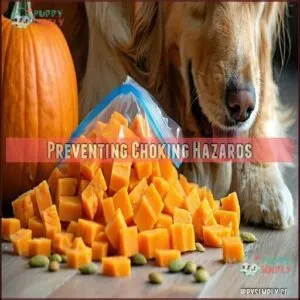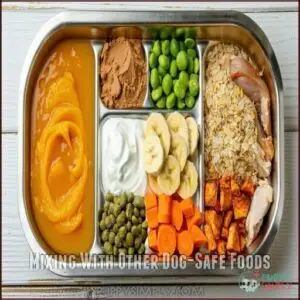This site is supported by our readers. We may earn a commission, at no cost to you, if you purchase through links.
 Yes, dogs can eat pumpkin, and it’s actually a great addition to their diet when prepared properly.
Yes, dogs can eat pumpkin, and it’s actually a great addition to their diet when prepared properly.
Pumpkin is full of fiber, vitamins like A and C, and potassium, which can support digestion and even help with upset stomachs or constipation.
Just make sure it’s plain, cooked pumpkin—not the sugary pie filling.
Avoid giving raw pumpkin or the seeds unless they’re roasted and unsalted.
Start with small amounts to see how your dog reacts.
Like anything, too much can cause problems, so moderation is key.
Pumpkin’s a safe treat that can keep tails wagging—and there’s more to learn about feeding it right.
Table Of Contents
- Key Takeaways
- Pumpkin Benefits Dogs
- Can Dogs Eat Pumpkin
- Preparing Pumpkin Safely
- Feeding Pumpkin Guidelines
- Frequently Asked Questions (FAQs)
- Is it harmful to dogs if they eat a pumpkin?
- Can dogs eat pumpkin safely?
- Is Pumpkin toxic to dogs?
- Can dogs eat pumpkin raw or cooked?
- How much pumpkin can a dog eat?
- What does pumpkin do for a dog?
- Does pumpkin help dogs with an upset stomach?
- How much pumpkin can I give my dog?
- Is canned pumpkin safe for dogs?
- Is pumpkin good for dog diarrhea?
- Conclusion
Key Takeaways
- Stick to plain, cooked pumpkin or canned puree without added sugars, spices, or salt to keep it safe for your dog.
- Pumpkin is great for digestion, helping with constipation, diarrhea, and overall gut health when served in moderation.
- Avoid raw pumpkin, skin, and unprepared seeds since they can cause stomach discomfort or choking hazards.
- Start with small amounts and watch for reactions; always check with your vet to determine the right portion for your dog.
Pumpkin Benefits Dogs
Pumpkin is packed with essential nutrients like fiber, vitamins, and minerals that support your dog’s overall health.
Pumpkin supports your dog’s health with fiber, vitamins, and minerals, boosting digestion, immunity, and overall wellness.
Its high fiber content promotes healthy digestion, while vitamins A and C boost the immune system.
Nutritional Value of Pumpkin
Pumpkin for dogs is packed with essential nutrients, making it a must-know for canine nutrition.
It’s rich in pumpkin vitamins like A, C, and E, which support immune health and vision. The mineral content, including potassium and iron, boosts overall wellness.
Plus, it’s a low-calorie option with no cholesterol.
Seeds even offer omega-3 benefits!
Additionally, pumpkin’s fiber content is great for dog’s digestive health.
Digestive Health Benefits
A dog’s belly thrives on good digestion, and pumpkin is a superstar regarding dog digestive health.
It’s packed with dietary fiber that improves stool consistency and promotes healthy gut bacteria. Plus, it works wonders for mild dog constipation relief or as a dog diarrhea remedy.
Some benefits include:
- Softening stools
- Supporting anal glands
- Balancing digestion
- Encouraging weight management
Immune System Support
Strong digestion lays the groundwork for a healthier immune system.
Pumpkin vitamins for dogs, like A, C, and E, along with antioxidants, give their immune system a much-needed boost.
Vitamin A supports cellular health, while lycopene benefits include infection resistance.
The pumpkin nutrients dogs need can improve their defenses, keeping illnesses at bay and helping them thrive.
Ensuring your dog gets enough omega-3 fatty acids can further reduce inflammation.
Can Dogs Eat Pumpkin
Yes, dogs can eat pumpkin, but it’s important to make certain it’s prepared properly.
You want to provide plain, cooked, or canned pumpkin, free from added sugars or unsafe spices like nutmeg.
Always check labels, as some pumpkin products contain harmful additives, such as xylitol, which is toxic to dogs.
Pumpkin for dogs offers great benefits when prepared safely, but there are risks to watch for.
Feeding too much can lead to digestive issues or vitamin A toxicity.
As with any squash, avoid toxic seasonings like garlic and onion.
If you’re using pumpkin seeds, proper seed preparation, like roasting them plain, makes them safer to digest.
Avoid letting your dog eat raw or rotting pumpkin, as it may cause stomach upset.
When done right, pumpkin can be a healthy addition to your dog’s diet.
Preparing Pumpkin Safely
If you’re feeding your dog pumpkin, it’s important to prepare it in a way that’s safe and easy to digest.
Stick to plain, cooked pumpkin or unsweetened canned puree, and avoid any added spices, sugar, or salt. Complete concepts
Cooking and Baking Methods
When preparing pumpkin for dogs, bake it at 350°F after cutting and scooping the seeds.
Roast skin-side down for 40 minutes to create dog-friendly pumpkin.
For puree, blend roasted chunks with water—ideal for dog pumpkin treats.
You can also try seed roasting by baking cleaned seeds for 15-20 minutes.
Many owners also choose to buy pre-made pumpkin snacks.
Avoid adding any unsafe spices to recipes.
Safe Ways to Feed Pumpkin
Once cooked or prepared, pumpkin offers great options as a treat. Stick to simple, dog-safe methods:
- Use 100% pure pumpkin puree, avoiding additives.
- Roast seeds lightly, unsalted, for a crunchy snack.
- Incorporate it into treat recipes for variety.
- Add small pumpkin serving sizes to meals for fiber or flavor.
To avoid digestive issues, remove the squash’s skin.
Your pup will enjoy the health benefits safely!
Preventing Choking Hazards
To prevent a choking hazard, always cut pumpkin into small bites and remove seeds that could cause blockages.
Avoid feeding the skin, as it’s tough to chew and digest. Supervise feeding to guarantee safe eating habits.
Pumpkin treats designed for dogs are a smart option for pet safety.
Consider purchasing safe pumpkin products designed specifically for canine consumption.
Proper preparation makes pumpkin a safe and healthy addition to your dog’s diet.
Mixing With Other Dog-Safe Foods
You can elevate dog pumpkin recipes by mixing pumpkin with other dog-safe foods.
Try these combinations:
- Yogurt combinations: Add plain, unsweetened yogurt for probiotics.
- Meat additions: Mix in shredded chicken or turkey.
- Vegetable blends: Pair with carrots or green beans.
- Grain options: Stir in cooked rice or oats.
Peanut butter, banana, or chicken broth also work well!
Many owners buy dog pumpkin yogurt products for convenience.
Feeding Pumpkin Guidelines
When feeding your dog pumpkin, it’s important to start with small portions to make certain they tolerate it well.
Stick to plain, unsweetened varieties and always check with your vet for the best serving size based on your dog’s needs.
Recommended Amounts by Dog Size
When feeding pumpkin, the recommended serving size depends on your dog’s size.
Small dogs need 2-3 teaspoons, while large breeds enjoy up to 5 tablespoons—pumpkin benefits tailored to their size!
Small dog portions range from 2-3 teaspoons, while large breed needs may reach up to 5 tablespoons. Stick to these pumpkin treat limits to maintain calorie intake balance.
Consult your vet for recommended dosage, ensuring your pup enjoys dog pumpkin benefits like improved digestion without overdoing it.
Signs of Too Much Pumpkin
Too much pumpkin can upset your dog’s digestion, leading to diarrhea in dogs or constipation in others.
Watch for signs like dog upset stomach, vomiting signs, lethargy issues, or allergic reactions.
Elevated vitamin A levels may cause toxicity and harm.
If diarrhea symptoms or unusual behavior appear, stop feeding and consult your vet to guarantee.
Adjusting Pumpkin Intake for Optimal Health
Adjusting how much pumpkin your dog eats takes attention to detail. Too little won’t help, while too much risks Fiber Overload or Vitamin Toxicity.
Portion Control is key—start small and increase gradually based on Individual Needs.
Guarantee Hydration Balance to support digestion when using pumpkin as a fiber supplement.
Squash offers similar benefits, providing essential nutrients and fiber. This helps relieve constipation in dogs, promoting healthy, consistent digestion.
Consultation and Monitoring by Veterinarian
Talk to your veterinarian before adding pumpkin to your dog’s diet.
A vet consultation guarantees personalized advice based on your dog’s size, digestion, and health.
They’ll help with dosage monitoring to prevent issues like diarrhea or constipation in dogs.
Watch for stool changes or allergy symptoms.
Internal medicine specialists can provide telemedicine internal consultations for a thorough care plan.
Veterinarian advice keeps pumpkin safe and effective for your pet’s needs.
Frequently Asked Questions (FAQs)
Is it harmful to dogs if they eat a pumpkin?
Like a comforting blanket, pumpkin can be safe for dogs when prepared right, but overdoing it or feeding raw parts can upset their stomach.
Stick to plain, cooked pumpkin, and avoid spices or additives.
Can dogs eat pumpkin safely?
Dogs can safely eat pumpkin when it’s plain and served in moderation.
Stick to cooked or canned pumpkin without additives.
Avoid raw pumpkin, skin, and seeds unless roasted.
Always check with your vet before introducing it.
Is Pumpkin toxic to dogs?
Pumpkin isn’t toxic to dogs, but moderation is key.
Too much can upset their stomach or lead to vitamin A toxicity.
Stick to plain, cooked, or canned pumpkin without additives for a safe treat.
Can dogs eat pumpkin raw or cooked?
Ever wonder if raw or cooked pumpkin is better for your dog?
Cooked pumpkin is safer and easier to digest.
Raw pumpkin can be tough on their stomach, so stick to plain, cooked options instead.
How much pumpkin can a dog eat?
Feed your dog 1 to 4 tablespoons of plain, cooked, or canned pumpkin per meal, depending on their size.
Start small to prevent digestive upset, and always check with your vet for personalized advice.
What does pumpkin do for a dog?
Adding pumpkin to your dog’s diet can improve digestion, ease constipation or diarrhea, and support a healthy gut.
Its fiber, vitamins, and prebiotics promote overall wellness, making it a nutritious, versatile treat when used moderately.
Does pumpkin help dogs with an upset stomach?
Over 60% of a pumpkin’s weight is water, making it a great choice for soothing an upset stomach.
Its fiber helps regulate digestion, firm loose stools, and ease mild constipation, keeping your dog comfortable.
How much pumpkin can I give my dog?
Start with 1-4 tablespoons of plain, canned pumpkin per meal, depending on your dog’s size.
Smaller dogs need less—just 1-2 teaspoons.
Always check with your vet before introducing it to their diet.
Is canned pumpkin safe for dogs?
Canned pumpkin is safe for dogs if it’s 100% pure with no added sugars, salt, or spices.
Avoid pumpkin pie filling, as it often contains harmful ingredients like nutmeg or xylitol that could hurt your dog.
Is pumpkin good for dog diarrhea?
An ounce of prevention is worth a pound of cure—pumpkin’s fiber can firm up loose stools or ease mild diarrhea.
Serve plain, unsweetened puree in small amounts, but consult your vet for serious issues.
Conclusion
Think of pumpkin as a quiet hero for your dog’s health, offering fiber, vitamins, and digestive support.
Yes, dogs can eat pumpkin, but stick to plain, cooked varieties in moderation.
It’s great for soothing upset stomachs or boosting nutrients, but too much can backfire.
Always start small, watch for reactions, and consult your vet if unsure.
Serve it safely by avoiding sugar, spices, and raw forms.
With care, pumpkin can be a paw-sitive addition to your dog’s diet! dogs can eat pumpkin, but stick to plain, cooked varieties in moderation.
- https://blufftonvet.com/
- https://www.merckvetmanual.com/toxicology/toxicities-from-human-drugs/multivitamins-and-iron-toxicity
- https://www.petpoisonhelpline.com/uncategorized/pumpkin-spice-naughty-nice/
- https://pets.webmd.com/dogs/guide/diet-nutrition
- https://www.akc.org/expert-advice/health/can-pumpkin-help-with-dog-diarrhea/















